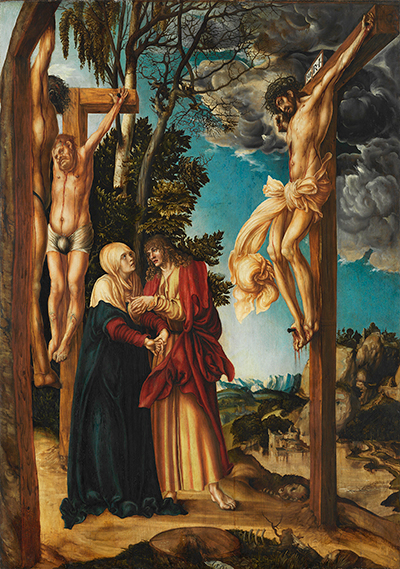In this painting of the Crucifixion, the crucified Christ appears to be surrounded by a group of people. To his right is John the Evangelist, the Virgin Mary and Mary Magdalene. In contrast, to his left, brutish soldiers ruthlessly cast dice to divide his garments.
The right hand of Christ shows the overwhelmed Virgins and the other believers. On the other hand, the less favored aspect of the cross is the critics of Christ and the cynics who rejected him. Behind the cross are monks, cardinals and Turks—who appear as a critique of the Catholic Church. Although Lucas Cranach was a friend of Martin Luther and a fervent supporter of the Reformation, his workshop was very successful, providing altarpieces for both Protestants and Catholics. In this painting, Cranach does not take stand in the doctrinal struggle, which grows from the preaching and writing of Luther since 1517.
From 1505 until his death, Cranach was a court painter of three consecutive electors of Saxony. He became Luther's best friend, lived in Wittenberg, in Saxony, and was considered a leader of the Reformation. Lucas Cranach lived at the center of the emerging Protestant religion. Here, the tension caused by religious divisions is visualized, emphasizing the central purpose of Luther's theology. This portrait is one of the first works by Lucas Cranach, completed shortly after his Vienna period. What makes this work unique is that the crosses are not arranged in line but together form a closed space, in which John and Mary are central.
The art of the Italian Renaissance well inspired Lucas Cranach. Its impact clearly shows in numerous works that allude to the education of modern liberals freed from medieval chains. Cranach organized a vast studio with his sons Lucas the Younger (1515-1586) and Hans (c. 1513-1537) as well as other disciples. Cranach and his studio produced over 400 paintings. Although Monogram LC signed the first works, in 1508, Duke Friedrich gave Cranach an emblem depicting a bat-winged snake with a ring on his mouth. Winged snakes can have a humanist or hieroglyphic meaning and can represent the Greek god of time, Kronos. Cranach has used this device in painting since 1508. However, since 1534, the wings of the snake have been birds and displayed as folded. This new format became popular after 1537.




